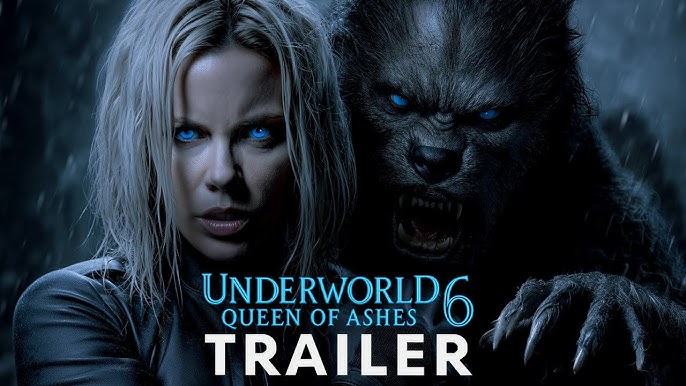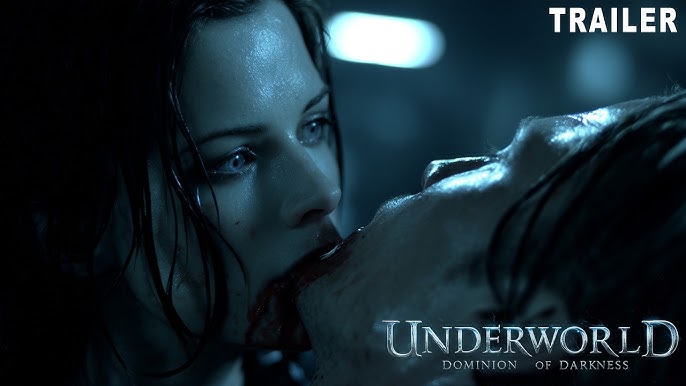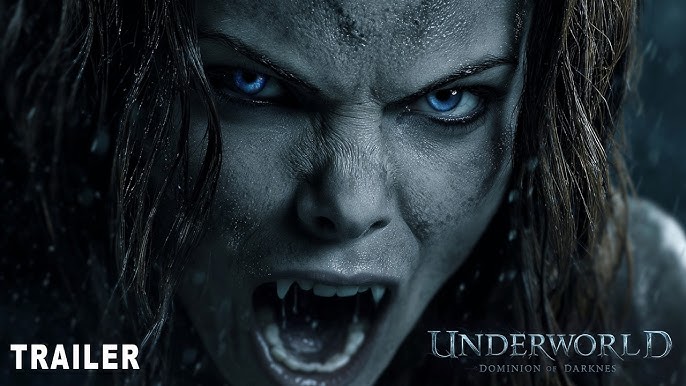Underworld 6 (2025)

Underworld 6: Rise of the Vampire (2025)
The war between vampires and Lycans has always been a conflict etched in blood, secrecy, and shadows, a war that has spanned centuries and shaped the balance of power in the dark underworld that lurks just beyond human perception. In Underworld 6: Rise of the Vampire, the franchise returns to its gothic, visceral roots, plunging audiences deeper into a world where every shadow hides a secret, and every alliance carries the weight of betrayal. Selene (Kate Beckinsale), the Death Dealer whose legacy has defined generations, once again steps into the heart of this relentless war—but this time, the threats she faces are unlike any she has ever encountered.
The story begins in a world teetering on the edge of collapse. The centuries-old truce between vampires and Lycans is crumbling, and the familiar battlefields have shifted. Humanity remains blissfully unaware of the shadow wars that rage in the dark corners of their cities, yet even in the modern age, the ancient rules of blood and power hold firm. Selene, who has survived countless battles and the machinations of power-hungry vampires, finds herself confronting a new, terrifying faction of vampires that emerges from the shadows. This faction is stronger, faster, and far more ruthless than any vampire Selene has faced before. They do not merely seek power—they crave domination, a total upheaval of the existing order, and a war that threatens to consume all that Selene has fought to protect.
From the opening sequence, the film establishes a tone of suspense, dread, and anticipation. The camera sweeps through moonlit cityscapes, abandoned castles, and underground labyrinths where the scent of blood and fear hangs heavy in the air. Gothic architecture dominates the skyline, a visual reminder that the world of vampires is one steeped in history, tradition, and perilous beauty. The filmmakers spare no expense in showcasing this universe, with the rumored $100 million budget evident in the elaborate sets, meticulous costume design, and breathtaking special effects. The vampires’ lairs are richly detailed, blending the opulence of centuries-old aristocracy with the raw, primal energy of creatures whose very existence is defined by predation. Lycans, on the other hand, are portrayed with a feral, visceral intensity, their transformations captured in fluid, horrifyingly beautiful CGI sequences that highlight their animalistic strength and relentless hunger.
Selene’s journey in this installment is as much internal as it is external. Haunted by her past, the ghosts of lost comrades, and the heavy burden of her own immortality, she must navigate a world where trust is fragile and loyalty is fleeting. As the new faction of vampires rises, she faces betrayals that cut deep, shifting alliances that challenge her judgment, and moral dilemmas that question the very nature of her identity. These internal struggles are mirrored in the external conflict, where combat sequences are more intense, fluid, and cinematic than ever before. The choreography combines martial arts, weapon-based combat, and supernatural abilities in a ballet of death and power, allowing Selene’s skill and determination to shine through even as the odds stack against her.
Central to the plot is the enigmatic leader of the new vampire faction, a figure shrouded in mystery and menace. Little is revealed about their origins initially, but their presence alone exudes a chilling charisma and authority that unsettles even the most seasoned vampires. This antagonist represents a new paradigm of vampire power—one that is unbound by the old hierarchies and traditions, one that sees fear as a weapon and domination as a birthright. Their strategies are calculated, their cruelty precise, and their willingness to eliminate anyone in their path, including fellow vampires, creates an atmosphere of tension that pervades the entire film. Selene’s confrontations with this figure are both physical and psychological, testing not only her combat prowess but also her resilience, intelligence, and capacity for leadership.
While action and suspense dominate the narrative, Underworld 6 also delves deeper into the lore and mythology of its universe. Flashbacks reveal the origins of vampire society, exploring forgotten histories, secret pacts, and ancient rivalries that have shaped the modern landscape. The writers expand on the rules of vampire abilities, the limits of Lycan transformations, and the delicate balance of power that governs the immortal world. This exploration enriches the story, providing context and depth to the conflicts while simultaneously expanding the mythology that fans have cherished for decades. Audiences are treated to revelations about the earliest vampires, the hidden motives behind centuries-old wars, and the personal histories of key characters whose past actions continue to reverberate in the present.
A critical element of the narrative is the evolving dynamic between vampires and Lycans. While previous installments focused heavily on their overt hostility, Rise of the Vampire presents a more nuanced picture. Some Lycans seek alliances with certain vampire factions, while others pursue their own agendas, independent of traditional rivalries. Selene must navigate this complex political landscape, negotiating fragile truces while remaining vigilant against those who would exploit any perceived weakness. These layers of strategy and subterfuge add a cerebral element to the story, ensuring that audiences are engaged not only by spectacular visuals and action sequences but also by the intricate power plays and moral ambiguities that define the immortal world.
The film’s visual style is a feast for the senses. Cinematographer [Director of Photography Name] employs a palette of moody blues, deep purples, and stark shadows to evoke the gothic horror that underpins the narrative. The lighting emphasizes contrasts between the cold elegance of vampire society and the raw brutality of Lycan enclaves, while practical effects, combined with cutting-edge CGI, create sequences of visceral beauty and tension. From rooftop chases under a full moon to cataclysmic battles in abandoned cathedrals, the set pieces are meticulously designed to maximize suspense, awe, and adrenaline.
Music and sound design play an equally critical role, with composer [Composer Name] delivering a haunting, orchestral score that weaves through the narrative, amplifying moments of suspense, heartbreak, and triumph. The soundscape blends ethereal tones with pulsating rhythms, underscoring the supernatural tension and enhancing the immersive experience. Fight sequences are punctuated by the sounds of claws tearing, swords clashing, and the echo of footsteps in empty corridors, creating an auditory tapestry that keeps audiences on edge from start to finish.
Supporting characters also receive significant development, adding emotional weight and complexity to the story. Loyal allies, unexpected betrayers, and morally ambiguous figures populate Selene’s world, each contributing to the rich tapestry of conflict and intrigue. Relationships are tested under extreme pressure, friendships are forged in fire, and sacrifices underscore the high stakes of a war that will determine the fate of vampire society. In particular, Selene’s interactions with younger vampires introduce themes of mentorship, responsibility, and the passing of knowledge across generations, providing a poignant counterpoint to the relentless violence and horror.
Beyond its immediate narrative, Underworld 6 explores broader themes of identity, legacy, and the cost of immortality. Selene’s journey is emblematic of the struggle to reconcile past actions with present responsibilities, to navigate a world that offers no guarantees, and to confront the inevitability of change in a realm that has long clung to tradition. The emergence of the new vampire faction serves as both a literal and symbolic challenge—an external threat that mirrors the internal conflicts of power, morality, and self-discovery that define Selene’s character arc.
As the climax approaches, tension escalates to breathtaking levels. Battles erupt in multiple locations simultaneously, each sequence crafted to showcase the unique strengths and vulnerabilities of vampires and Lycans alike. Selene confronts the faction leader in a showdown that combines raw physical combat with supernatural abilities, strategic cunning, and emotional resonance. The resolution of this conflict carries significant consequences, reshaping alliances, redefining power structures, and setting the stage for potential future installments in the franchise.
Ultimately, Underworld 6: Rise of the Vampire delivers a cinematic experience that satisfies both longtime fans and newcomers to the franchise. It combines gothic horror, pulse-pounding action, and rich mythology in a way that is visually stunning, narratively compelling, and emotionally resonant. With its $100 million budget, the film does not shy away from spectacle, offering breathtaking visual effects, meticulously choreographed fight scenes, and immersive world-building that transports audiences into a dark, dangerous, and utterly captivating universe.
In conclusion, Rise of the Vampire is more than just another chapter in the Underworld saga—it is a bold, ambitious exploration of the eternal struggle between power and morality, loyalty and betrayal, humanity and monstrosity. Selene’s journey is at once epic and intimate, thrilling and haunting, offering audiences an unforgettable ride through a world where the night belongs to the immortals and survival is defined by cunning, courage, and the unbreakable will to endure. Fans of the franchise can expect a film that honors the legacy of its predecessors while pushing boundaries, raising stakes, and redefining what it means to fight for one’s place in a world where darkness reigns supreme.
⭐ Rating: 5/5
Related Movies







